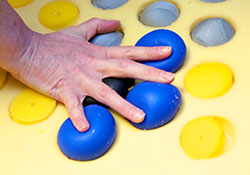Office of Research & Development |
 |
Office of Research & Development |
 |

VA Research Currents archive
Posted July 16, 2013
(Summer 2013 VA Research Currents)

A team at VA's Advanced Platform Technology Center, in Cleveland, is using advanced gel balls to create a new type of seat cushion to help prevent pressure ulcers among wheelchair users. (Photo by Jason Miller)
When it comes to pressure ulcers, an ounce of prevention is worth a ton of cure. "It's always better to prevent a pressure ulcer than to treat one," says Kath Bogie, DPhil, a researcher at VA's Advanced Platform Technology (APT) Center in Cleveland.
Bogie's group, with members at both APT and Case Western Reserve University, is developing a low-tech, high-performance product they hope will help prevent pressure ulcers for the more than 25,000 VA patients with spinal cord injuries, and for all others in the U.S. and worldwide who are long-term wheelchair users.
The product is a seat cushion. The basic idea is not new—there are "high-performance" models already on the market. Bogie's innovation lies in the materials and design. The group is developing its own low-cost gel filling, along with a modular design that will help save users money. She calls the approach "value-driven engineering."
"We'll provide advanced adjustable pressure relief at a much lower cost to VA and other consumers," says Bogie. "The up-front cost is less due to the cushion materials, and ongoing costs are reduced because the design is modular—so that if one part fails, it can be replaced without having to throw out the whole cushion."
She expects the annual cost of the new cushion to come out to around $57 per year, compared to $128 for existing models. "Our preliminary cost analysis shows that a customer could entirely replace every component of the proposed cushion several times and still have a more cost-effective cushion."
The gel balls in the APT model should last about six months. A washable two-way stretch cover will be included in the final product.
The group is planning trials with Veterans with spinal cord injury. The researchers will also test the cushions using a machine that creates heat and water vapor, mimicking the sweat and body heat the cushions will endure in real use. They'll also use pressure-mapping technology to study how a load is distributed across the cushion when it's in use.
The work is funded by VA's Rehabilitation Research and Development Service. Bogie is also an assistant professor at Case Western Reserve University. Her collaborators include bioengineers Jeffrey Capadona, PhD, with APT and CWRU; and John Lewandowski, PhD, with CWRU.